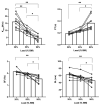Electromyography, Stiffness and Kinematics of Resisted Sprint Training in the Specialized SKILLRUN® Treadmill Using Different Load Conditions in Rugby Players
- PMID: 34833557
- PMCID: PMC8622140
- DOI: 10.3390/s21227482
Electromyography, Stiffness and Kinematics of Resisted Sprint Training in the Specialized SKILLRUN® Treadmill Using Different Load Conditions in Rugby Players
Abstract
This study's aim was to analyze muscle activation and kinematics of sled-pushing and resisted-parachute sprinting with three load conditions on an instrumentalized SKILLRUN® treadmill. Nine male amateur rugby union players (21.3 ± 4.3 years, 75.8 ± 10.2 kg, 176.6 ± 8.8 cm) performed a sled-push session consisting of three 15-m repetitions at 20%, 55% and 90% body mas and another resisted-parachute session using three different parachute sizes (XS, XL and 3XL). Sprinting kinematics and muscle activity of three lower-limb muscles (biceps femoris (BF), vastus lateralis (VL) and gastrocnemius medialis (GM)) were measured. A repeated-measures analysis of variance (RM-ANOVA) showed that higher loads during the sled-push increased (VL) (p ≤ 0.001) and (GM) (p ≤ 0.001) but not (BF) (p = 0.278) activity. Furthermore, it caused significant changes in sprinting kinematics, stiffness and joint angles. Resisted-parachute sprinting did not change kinematics or muscle activation, despite producing a significant overload (i.e., speed loss). In conclusion, increased sled-push loading caused disruptions in sprinting technique and altered lower-limb muscle activation patterns as opposed to the resisted-parachute. These findings might help practitioners determine the more adequate resisted sprint exercise and load according to the training objective (e.g., power production or speed performance).
Keywords: loaded sprint; muscle activation; performance; sled-push; team-sports.
Conflict of interest statement
The authors declare no conflict of interest. The funders had no role in the design of the study; in the collection, analyses, or interpretation of data; in the writing of the manuscript, or in the decision to publish the results.
Figures



Similar articles
-
Muscle Activity, Leg Stiffness, and Kinematics During Unresisted and Resisted Sprinting Conditions.J Strength Cond Res. 2022 Jul 1;36(7):1839-1846. doi: 10.1519/JSC.0000000000003723. Epub 2020 Jul 9. J Strength Cond Res. 2022. PMID: 32658032
-
Impact of Sled Loads on Performance and Kinematics of Elite Sprinters and Rugby Players.Int J Sports Physiol Perform. 2022 Mar 1;17(3):465-473. doi: 10.1123/ijspp.2020-0867. Epub 2021 Dec 29. Int J Sports Physiol Perform. 2022. PMID: 34965512
-
Acute Effects of Progressive Sled Loading on Resisted Sprint Performance and Kinematics.J Strength Cond Res. 2022 Jun 1;36(6):1524-1531. doi: 10.1519/JSC.0000000000003656. Epub 2020 Jun 19. J Strength Cond Res. 2022. PMID: 32614156
-
The Longitudinal Effects of Resisted and Assisted Sprint Training on Sprint Kinematics, Acceleration, and Maximum Velocity: A Systematic Review and Meta-analysis.Sports Med Open. 2024 Oct 11;10(1):110. doi: 10.1186/s40798-024-00777-7. Sports Med Open. 2024. PMID: 39392558 Free PMC article. Review.
-
The effects of lower limb wearable resistance on sprint running performance: A systematic review.Eur J Sport Sci. 2020 Apr;20(3):394-406. doi: 10.1080/17461391.2019.1629631. Epub 2019 Jul 2. Eur J Sport Sci. 2020. PMID: 31177935
Cited by
-
Quantification of horizontal force for the EXER-GENIE® resisted sprint training device.Front Sports Act Living. 2023 Aug 30;5:1231371. doi: 10.3389/fspor.2023.1231371. eCollection 2023. Front Sports Act Living. 2023. PMID: 37712007 Free PMC article.
-
The use of wearable resistance and weighted vest for sprint performance and kinematics: a systematic review and meta-analysis.Sci Rep. 2024 Mar 5;14(1):5453. doi: 10.1038/s41598-024-54282-8. Sci Rep. 2024. PMID: 38443408 Free PMC article.
References
-
- Cupples B., O’Connor D. The Development of Position-Specific Performance Indicators in Elite Youth Rugby League: A Coach’s Perspective. Int. J. Sports Sci. Coach. 2011;6:125–141. doi: 10.1260/1747-9541.6.1.125. - DOI
-
- von Lieres Und Wilkau H.C., Irwin G., Bezodis N.E., Simpson S., Bezodis I.N. Phase analysis in maximal sprinting: An investigation of step-to-step technical changes between the initial acceleration, transition and maximal velocity phases. Sports Biomech. 2020;19:141–156. doi: 10.1080/14763141.2018.1473479. - DOI - PubMed
MeSH terms
LinkOut - more resources
Full Text Sources
Miscellaneous

